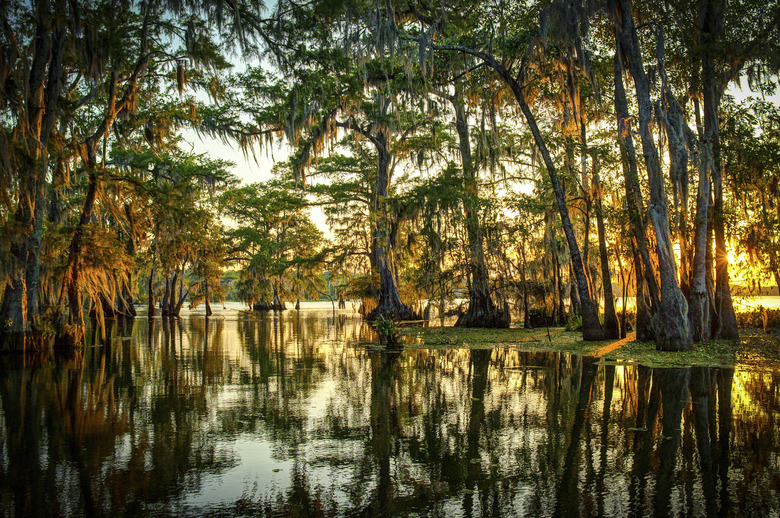Climate Of Wetland Swamp Ecosystems
A swamp is defined as a wetland dominated by trees or dense shrub thickets, although in popular parlance it's commonly applied to many other sodden ecosystems, including marshes, bogs, fens and mires. True swamps are found from the subarctic to the heart of the tropics, native to a significant range of climate zones. They may be permanent or seasonal in nature, and when left undisturbed, foster a wild, primal atmosphere.
Climatic Criteria
Climatic Criteria
Swamps require adequate precipitation to feed seasonally flooded rivers and high water tables and to collect in slow-draining depressions — conditions met in places from tropical-wet to subarctic climate zones. However, such locations, varied as they are, must also have the correct temperature and precipitation patterns for tree or shrub growth, as the absence of a dense population of woody plants defines a waterlogged basin, rather than a swamp.
Examples
Examples
Floodplain swamps, which develop on the bottomlands that surround rivers, are most extensive in the tropics and subtropics. The Amazon Basin of northern South America and the Congo Basin of equatorial Africa both harbor vast swamp forests in a mosaic with lowland tropical rainforest. Big bottomland swamps also prevail across much of the southeastern U.S., carpeting the floodplains of big rivers like the Mississippi, Atchafalaya and Altamaha. Mangrove swamps — defined by semi-aquatic, salt-adapted trees that don't tolerate frost or freezing — proliferate most in tropical climates, particularly along tidal rivers and within estuary-delta complexes. Biggest is the Sundarbans, an enormous, tiger-prowled mangrove kingdom where the Ganges-Brahmaputra Delta flows into the Bay of Bengal.
Seasonal Cycles
Seasonal Cycles
Swamps that are only seasonally inundated are common in regions where hydrological patterns vary markedly across the year. Swamp-specialist trees are often more resilient in the face of both extended inundation and drought than marsh vegetation. The amount of time in which a swamp has standing water is called its "hydroperiod." The water level in wet- and dry-season swamps can rise and fall in concert with the water table. Similarly, a floodplain swamp may be mostly dry outside seasonal high-water periods, during which swollen rivers overspill their banks.
Climatic Disturbances: Cyclones
Climatic Disturbances: Cyclones
In many parts of their great brackish range — from the Caribbean to the Philippines — mangrove swamps regularly contend with tropical cyclones. Hurricanes in the coastal Everglades, for example, can topple old, tall mangroves outright or choke whole groves with seafloor muck, creating ghost woods of standing snags and bleached logs. Mangrove swamps are considered important cyclone and hurricane buffers. Where intact, they can take the brunt of an incoming storm and storm surge, lessening damage to human life and property inland.
References
- U.S. Environmental Protection Agency: Swamps
- World Wildlife Fund: Amazon Floodplain Forests
- World Wildlife Fund: Congo Basin
- Priceless Florida: Natural Ecosystems and Native Species; Ellie Whitney, et al.
- The Everglades Handbook: Understanding the Ecosystem; Thomas E. Lodge
- TreeHugger; Mangrove Loss Left Burma Exposed to Cyclone; Lloyd Alter
Cite This Article
MLA
Shaw, Ethan. "Climate Of Wetland Swamp Ecosystems" sciencing.com, https://www.sciencing.com/climate-wetland-swamp-ecosystems-4535/. 13 March 2018.
APA
Shaw, Ethan. (2018, March 13). Climate Of Wetland Swamp Ecosystems. sciencing.com. Retrieved from https://www.sciencing.com/climate-wetland-swamp-ecosystems-4535/
Chicago
Shaw, Ethan. Climate Of Wetland Swamp Ecosystems last modified August 30, 2022. https://www.sciencing.com/climate-wetland-swamp-ecosystems-4535/
